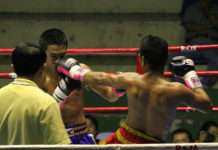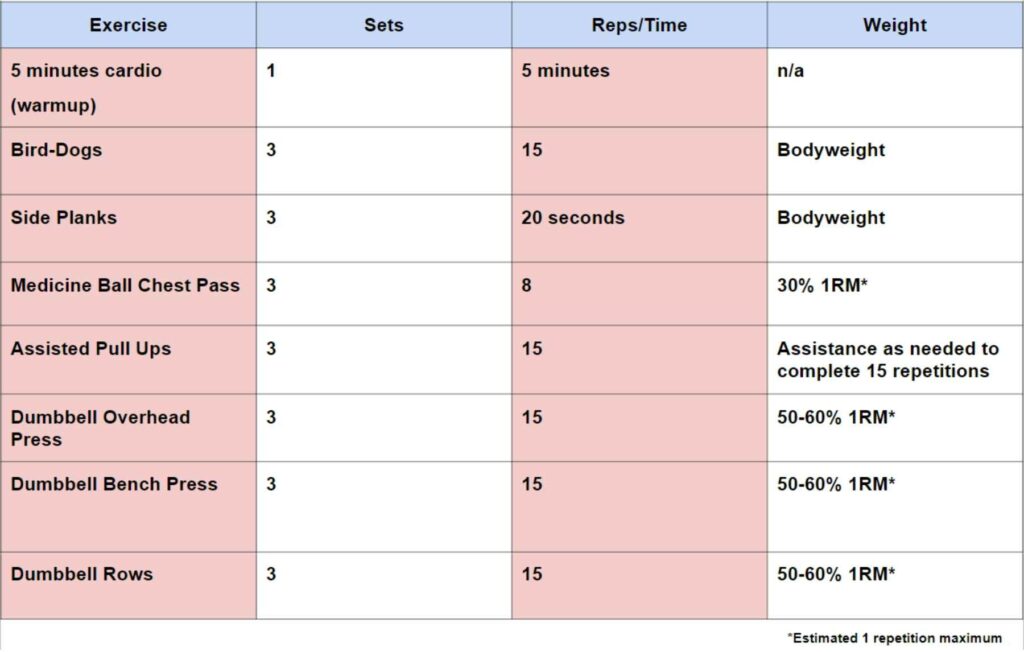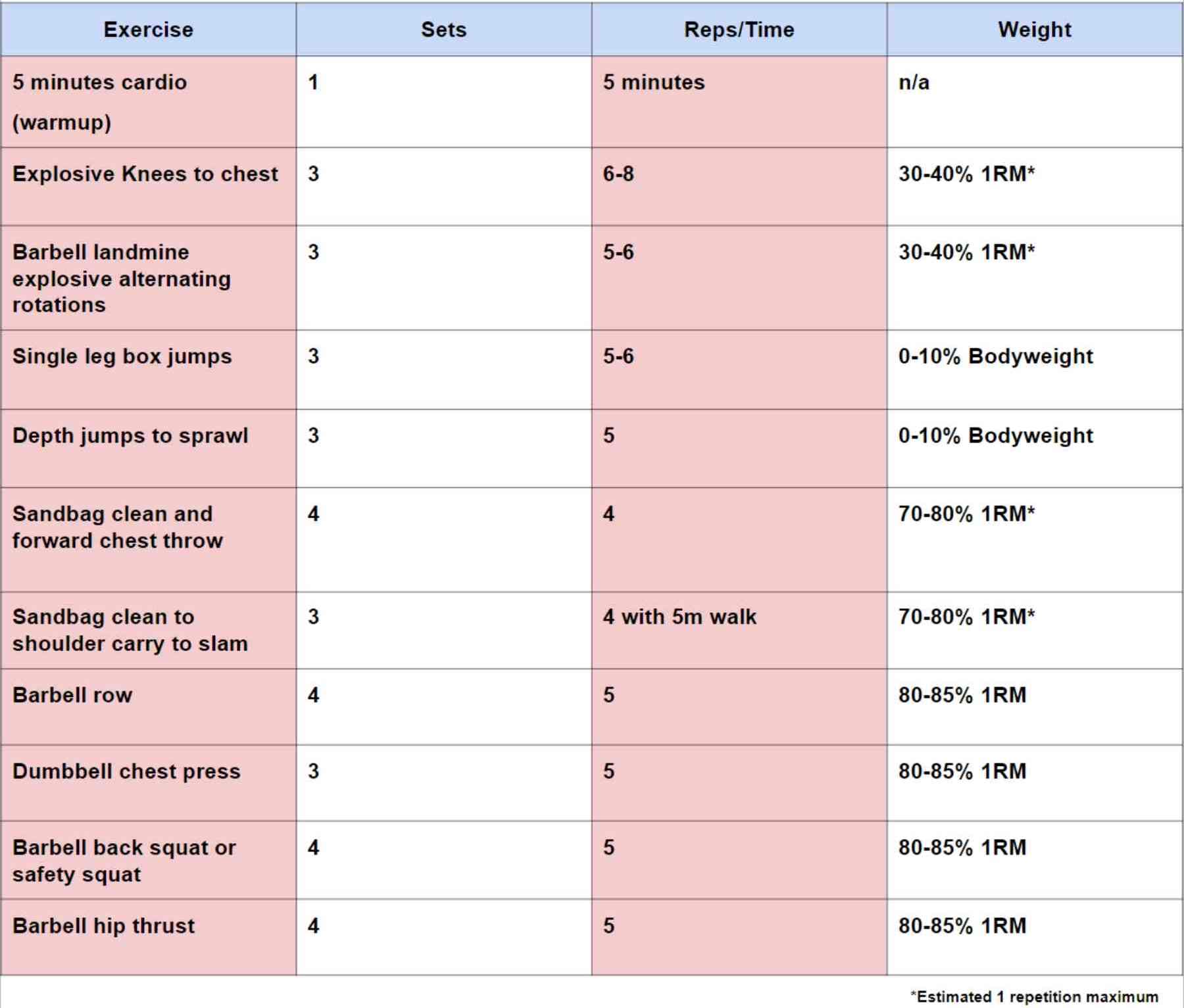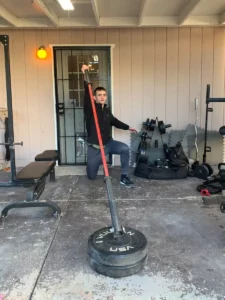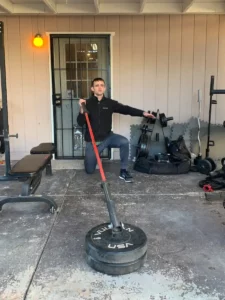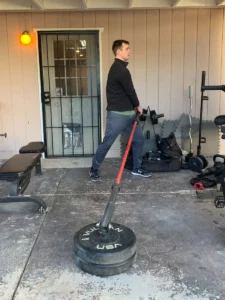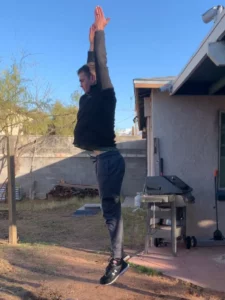Maximizing your Brazilian Jiu Jitsu longevity, injury resistance, and performance requires the best BJJ strength and conditioning program.
You need to perform the right BJJ workout if you want to perform well over the long run.
Don’t worry, we are here to help you find a strength and conditioning program for Jiu-Jitsu that matches your goals, experience, and equipment availability.
Each workout for BJJ in the program will bring you closer to your Jiu Jitsu strength and performance goals.
I’ve been training Brazilian Jiu-Jitsu since 2016 and have been a certified personal trainer and strength and conditioning specialist for over 5 years. I have trained myself and other Jiu Jitsu practitioners over the years for improved strength, muscle growth, and conditioning for BJJ.
I also consulted with three BJJ and martial arts expert coaches: Alex Sterner, Jimmy House, and Dr. Richard Maak. Each helped give additional insight from many years of training and coaching BJJ athletes of all levels.
Strength and conditioning for grappling requires a few considerations beyond cookie-cutter workout programs.
This article looks at the following aspects of the best workouts for BJJ fighters:
- Muscles used in BJJ
- BJJ strength workout plans
- Jiu Jitsu exercises to include in your training program
- How to design your own BJJ workout
- Expert coach opinions on BJJ workouts
- The scientific basis for Jiu Jitsu strength training
- Frequently asked questions on BJJ training programs
By the time you’ve finished reading, you’ll be ready to design your own science-based BJJ workout program.

Jiu Jitsu Workout Routines Quick Breakdown
BJJ Workout Principles
- The goal of a BJJ workout is to improve overall fitness, strength, and endurance.
- BJJ workouts typically include exercises such as push-ups, pull-ups, squats, burpees, and other dynamic movements.
- BJJ workouts should be tailored to the individual’s goals and skill level.
- A BJJ workout should be challenging but not so difficult that it leads to injury.
- Jiu Jitsu workouts should include a warm-up and cool-down period.
- Brazilian Jiu-Jitsu workouts should include stretching and mobility exercises to help prevent injury.
- Vary the workout every 12-24 weeks to keep the body and mind challenged.
Muscular Endurance Training Routine
Muscle Building Workouts
Maximal Power and Strength Workouts
Workout Goals for the BJJ Fighter – Should You Lift Weights for BJJ?
Many old school BJJ guys throughout history used to say that BJJ practice was all you need, since technique beats size and strength.
However, in the new era of modern BJJ with instructors who understand fundamental exercise science principles, things have changed.
Regardless of their skill level, Jiu Jitsu fighters need to work on many different athletic traits if they are serious about injury prevention, performance, and longevity in BJJ.
The best BJJ strength and conditioning programs address each of these to the extent possible in each athlete.
These traits include:
- Flexibility and mobility in the hips and shoulders
- Muscular endurance
- Stability and control during dynami
- Grip and upper body strength
- Lower body strength and power
- Anaerobic and aerobic conditioning
- Muscle mass as a foundation for developing strength
If you ignore one or more of these traits in your BJJ strength development routine, you are leaving a lot on the table and risking BJJ injury and underperformance in the long run. This is true whether you train BJJ for self defense, competitions, or just general health and fitness.
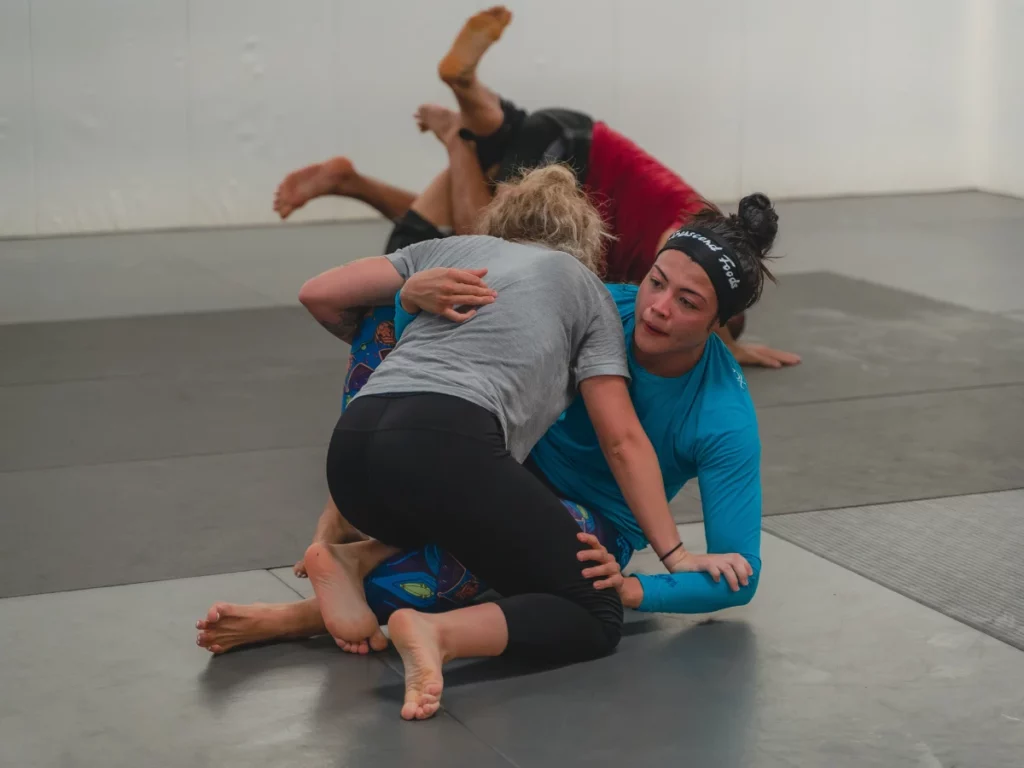
Since Brazilian Jiu-Jitsu includes sweeps, standup, throws, pressure, and all manner of forces on the body, you need to keep yourself strong to avoid injury.
Other martial arts styles such as boxing, Judo, karate, forms of Chinese Kung Fu, and mixed martial arts also benefit from strength development.
Strength, power, and mobility make kicks, punches, weapons, and other self defense techniques more effective in sparring, competition, and in real fights.
Plus, strength and conditioning improves overall quality of life.
Muscle Growth for BJJ – How Big Should You Be?
Everyone knows that focusing on big, bulky muscles is not always the best approach for BJJ.
Does this mean you shouldn’t build muscle for BJJ?
No!
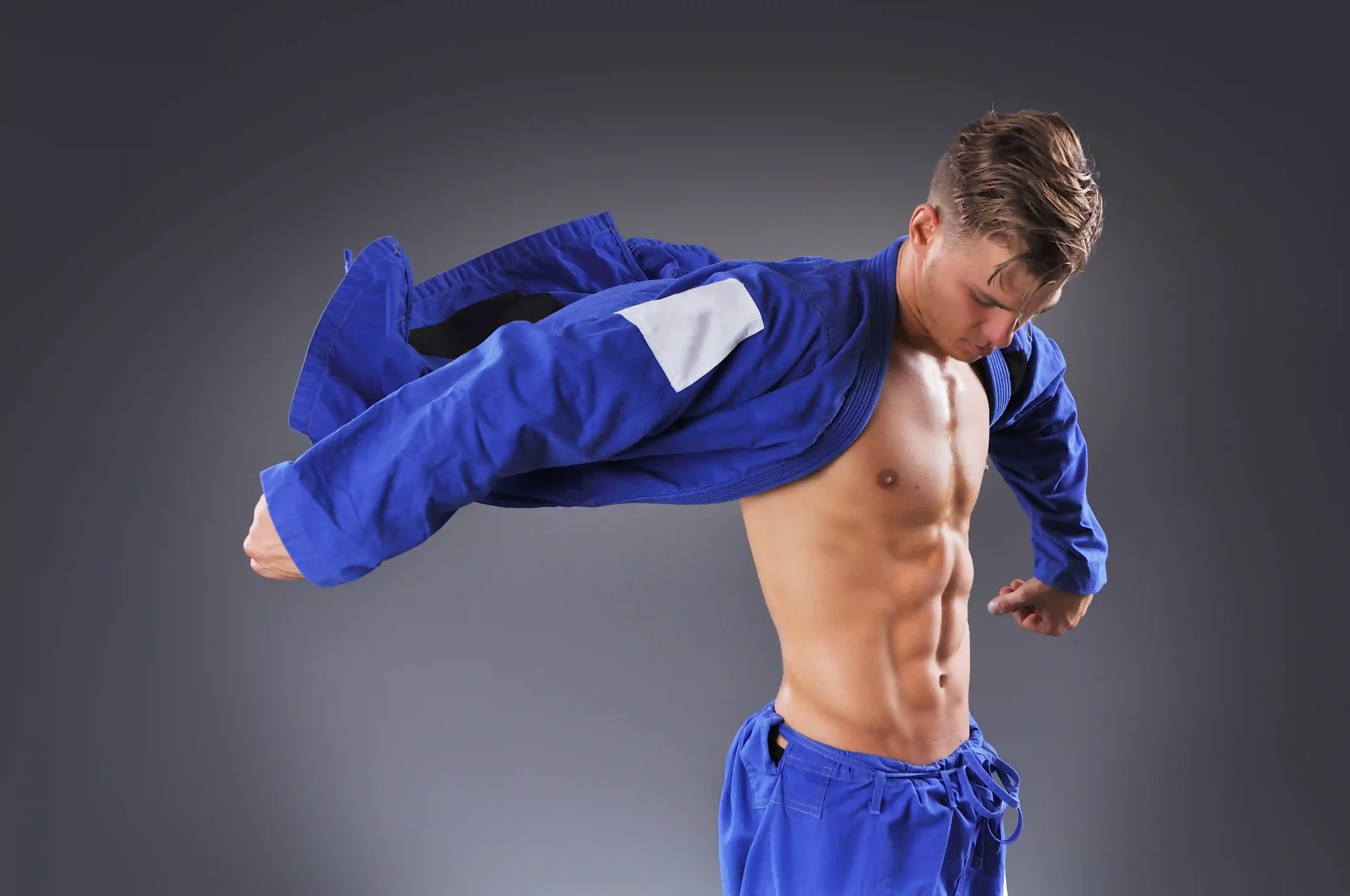
To put it simply, if you have never lifted weights and do not naturally have a lot of muscle mass, you are almost always going to benefit from 3 to 6 months of hypertrophy (muscle-building) training.
You are likely to add 4-8 pounds to your muscle tissues in that timeframe. Not enough to put you on a bodybuilding stage by any means.
However, these additional muscle fibers can then be honed for strength, power, and BJJ technique. You need a muscular platform to develop real strength.
If you already have a good amount of muscle mass, you can put less emphasis on building muscle for BJJ.
Most resistance training exercises performed in the 8-15 rep range will drive muscle fiber growth.
Focus on tension throughout each repetition to maximize hypertrophy.
For BJJ competitors, being as muscular as possible for your weight class is definitely beneficial for competitions.
Mobility Training for BJJ

Mobility refers to the relative ability of a joint or series of joints to move through a given range of motion.
The definition of good mobility” depends on the context, you don’t need endless flexibility for BJJ. However, I use the following benchmarks to assess how much emphasis should go on mobility:
- Ability to enter a full-depth squat without major movement compensation
- Ability to raise arms overhead without shrugging the shoulders or losing posture
- Ability to enter a pigeon or pretzel stretch and achieve 90 degrees of hip external rotation
These are just a few mobility tests/checkpoints you can use to determine your relative mobility.
Hip mobility is essential for many techniques in BJJ, such as the BJJ triangle, S-mount position, and leglock entanglements.
I recommend an extra focus on mobility for BJJ if this is something you struggle with. If you have good mobility, be sure to maintain with weekly stretching.
Additionally, always use the fullest range of motion when performing any resistance exercises, which will maintain and even improve overall Jiu Jitsu mobility.
Additionally, stretching after your workout can reduce muscle soreness.
Yoga for BJJ or a general stretching routine are both great options.
Example mobility exercises for BJJ include:
- Seated and standing hamstring stretches
- Static and dynamic lunges
- Seated hip rotations in the 90-90 or pigeon position
- Downward dog to plank flows
- Calisthenics
Check the video below for a full 30 minute BJJ Mobility Routine:
Mobility for BJJ
WORKOUT APP (FREE FAT LOSS / AT HOME PROGRAMS): https://www.bodyweightwarrior.co.uk/appFREE PDF DOWNLOAD: https://www.bodyweightwarrior.co.uk/blog/30-min-bjj...
Muscular Endurance
Muscular Endurance is the ability of individual muscles to exert submaximal force for medium durations.
Training examples include performing many lighter pushups or squats. Most fitness training guidelines call for developing muscular endurance as the first main goal of a program.
This gives athletes a chance to develop movement competency at lighter weights and also starts building some muscle and strength that can be further expanded upon.
In BJJ if you’ve ever felt a “burn” in a specific area of your body after repeated movements, this is a sign that your muscular endurance is reaching its limit in that area, even if you are not breathing hard.
I recommend focusing on muscular endurance as a program goal, rather than mixing and matching high rep and low rep within the same workout. This means doing sets of 12-30 repetitions with light to medium weight.
Muscular endurance workouts for BJJ are also great at home BJJ workout options. Body weight BJJ workout programs tend to be effective for high-repetition training.
If you want to do your BJJ workout at home, I recommend looking into our bodyweight BJJ workout routine.
Stability Training for BJJ

Stability is your body’s ability to stop movement at a given joint. Stability in the core is the main focus. Most powerful movements require that you stabilize your core as you activate muscles in your hips or shoulders to initiate movement.
Developing the ability to contract your core as you perform functional movements is key for both injury prevention and performance.
Core exercises such as bird-dogs, side planks, and kettlebell movements like Turkish get ups are phenomenal ways to build excellent stability for BJJ.
I generally include BJJ core exercises in each lifting working as opposed to a dedicated BJJ core workout.
Upper Body and Grip Strength for BJJ
Jiu Jitsu involves a ton of gripping and pulling movements. As such, upper body and grip strength and vital for Jiu Jitsu strength and conditioning programs.
Thankfully, most rowing and pullup motions train both at the same time. You can utilize a thicker bar, rope, or other methods to improve grip strength as well.
I don’t recommend entire workout routines for grip strength only. However, including a few fat bar pulls or heavy farmers’ carries can go a long way towards building an incredibly strong grip.
Lower Body Strength and Power for BJJ
Lower body strength and power includes the core and hip muscles as well as every muscle from your foot to your waist. Research from Karsten Øvretveit in 2018 found substantial improvements in BJJ performance and athletic abilities through near-maximal strength training.
Virtually all explosive athletic movements begin with the hips, and BJJ is no exception. From aggressive guard passing to finishing many submissions, the ability to use the power of your hips is make-or-break for BJJ performance.
Exercises to train the hips for BJJ include variations of squats, deadlifts, lunges, hip thrusts, leg raises, and lower body plyometrics.
Conditioning for BJJ

Conditioning for BJJ refers to your body’s ability to sustain repeated outputs over time without excessive drop in performance.
You need both anaerobic conditioning (fast bursts of explosive movement followed by brief recovery) and aerobic conditioning (ability to sustain lower intensities for long periods) to maximize your all around BJJ cardio.
Depending on your training and goals, you can do all your BJJ conditioning through fast-paced drilling and rolling in BJJ.
You can also perform separate sessions on the AirDyne bike or HIIT circuits – although many coaches such as Alex and Dr. Richard Maak prefer to focus on strength and sport-specific work, using BJJ as the primary modality for improving cardio.
Muscles Used in BJJ
Brazilian Jiu-Jitsu requires work from most of the major muscles in your body. I’ve grouped them according to regions of the body.
Your style of BJJ will often determine which specific muscles will be more emphasized during rolling. For example, playing guard emphasizes the hip flexors and shins. However, you should not change your Jiu Jitsu lifting program based on your play style.
The optimal balance of strength between opposing muscle groups will require a full body training program.
The best workouts for Jiu Jitsu will include exercises targeting these muscles in compound movements.
This is a general list and cannot list every muscle used, but it’s a good overview.

Lower body and leg muscles for BJJ
The main lower body muscles used in BJJ include the muscles in your legs and hips:
- Gluteus maximus, medius, & minimus (glutes/hip abductors, extensors, and rotators)
- Vastus lateralis, vastus medialis, rectus femoris* (quads)
- Adductor longus, adductor brevis, adductor magnus, gracilis, pectineus (adductors)
- Biceps femoris, semitendinosus, semimembranosus (hamstrings)
- Psoas, pectineus, iliacus, sartorius, rectus femoris (hip flexors)
- Lateral & medial gastrocnemius, soleus (calves)
- Tibialis (shin muscles)
Core muscles used in BJJ
- Transverse abdominis, rectus abdominis, internal & external obliques (abdominals)
- Erector spinalis, longissimus, & iliocostalis (spinal erectors)
- Multifidus, quadratus lumborum, diaphragm, psoas (trunk stabilizers)
*Note: some muscles play multiple roles in the human body and are thus included twice.
Upper body muscles used in BJJ
- Pectoralis major & minor (pecs/chest muscles)
- Anterior, medial, & posterior deltoids (shoulder)
- Subscapularis, infraspinatus, teres minor, supraspinatus (rotator cuff)
- Latissimus dorsi, levator scapulae, rhomboids, trapezius (upper back muscles)
- Sternocleidomastoid, deep cervical flexors, suboccipitals, trapezius, levator scapulae (neck muscles)
- Forearm flexor, rotator, and extensor muscles (numerous)
Overall, the program design I lay out in this article covers the major muscle groups used as well as some of the smaller muscles.
You can always target certain specific areas with more focus (ie neck, forearms), but given practical time and training demands, this program focuses on general strength and conditioning.

Beginner BJJ Strength and Conditioning Program
This BJJ strength training program is aimed at beginners who are new to lifting weights and performing resistance exercise, regardless of BJJ belt level.
The focus of the program is on higher repetition range to help in developing the correct movement patterns, muscular endurance, control, and stabilization before trying to maximally load each movement.
The importance of developing your movement skill level vital.
The training workout includes bodyweight training and exercises that require gym equipment.
These BJJ strength development workout sessions are the time to focus on exercise technique when performing each repetition.
This two-day strength training for BJJ will build a ton of early physiological adaptations if you are someone who has not lifted weights in the past.
In the long run you need to lift heavier and explosively to drive strength, muscle, and power adaptations.
However, if you are new to lifting, then you will see gains in strength and muscle size even on a higher repetition program.
The program is split into 2 workouts per week and assumes you are training BJJ an average of 3 days per week.
After following the program for 12 weeks, you should be ready to transition to the recreational athlete’s Jiu Jitsu workout plan.
Example goal: muscular endurance, conditioning (secondary)
Split: Two days lifting, one day HIIT
Upper Body
Warm Up:
- 5 minutes AirBike low intensity
Core:
- Bird-dogs – 3 x 10 reps with 1 second end range hold
- Side planks – 3 x 20 second holds
Plyometrics:
- Medicine ball chest pass – 3 x 8 reps
Resistance Training:
- Pull ups/assisted pull ups – 3 x 15 repetitions
- Dumbbell overhead press 3 x 15-20 repetitions
- Dumbbell bench press – 3 x 15-20 repetitions
- Dumbbell Rows – 3 x 15-20 repetitions
Lower Body
Warm Up:
5 minutes AirBike low intensity
Core:
- Bird-dogs – 3 x 10 reps
- Side planks – 3 x 20 second holds per side
Plyometrics:
- Double-leg hops – 3 x 6-10
- Jump squats – 3 x 6-10
Implement training:
- Kettlebell swings – 3 x 15
- Goblet squats – 3 x 15
Resistance Training:
- Hex bar deadlift – 3 x 15
- Split squat – 3 x 15
- Barbell hip thrust 3 x 15
Conditioning (optional)
- 3 x 5 rounds of 30 seconds on/30 seconds off for any of the following modalities:
- AirBike (can use for entire workout)
- Rower (can use for entire workout)
- Track, field, or treadmill sprinting (can use for entire workout)
- Resistance exercises using 30% 1RM (perform each exercise once per round)
- Recommend using primarily lower body strength and plyometric movements
Intermediate Pulling Jiu Jitsu Workout for Muscle Building
Intermediate Pressing Jiu Jitsu Workout for Muscle Building
Intermediate Lower Body Jiu Jitsu Workout for Muscle Building
This BJJ workout program is designed for athletes with basic resistance training movement competency. This is designed to increase muscle mass, develop strength in the medium-rep range, and develop submaximal power.
The workout includes core training, explosive plyometric movements, full body power and coordination with kettlebell and sandbag training, and finally, traditional resistance exercises focused on muscular hypertrophy.
Collectively, these strength training exercises for BJJ will develop strength and power as well, but the main adaptation will be muscular fiber size increases.
Follow the program for at least 3-6 months. You can switch out similar exercises every 8-12 weeks, but follow the overall program structure.
Example goal: muscular hypertrophy, power (secondary)
Split: three days lifting
Upper Body Pressing
Warm Up:
- 5 minutes AirBike low intensity
Core:
- Side planks – 3 x 10 side bridge reps on each side
- Hollow body rock – 3 x 10 rocks
- Barbell landmine twist
Plyometrics:
- Medicine ball overhead toss – 3 x 5-8 reps
- Explosive push ups – 3 x 5-8 reps
Implement training:
- Kettlebell Turkish Get-Up – 3 x 3-5 reps per side
Resistance Training:
- Parallel bar/ring dips – 3 x 8-12
- Barbell overhead press 3 x 8-12
- Barbell bench press – 3 x 8-12
- Incline dumbbell chest press – 3 x 8-12
- Dumbbell pec fly – 3 x 8-12
Lower Body
Warm Up:
- 5 minutes AirBike low intensity
Core:
- Bird-dogs – 3 x 10 reps with 5 second end range hold
- Side planks – 3 x 30 second holds
Plyometrics:
- Box jumps – 3 x 6-10
- Alternating split jumps – 3 x 6-10
Implement training:
- Sandbag clean and front rack carry – 3 rounds of 20 meter carries
- Kettlebell snatch (if technique knowledge) – 3 x 5-10 reps
Resistance Training:
- Barbell back squat – 3 x 8-12
- Romanian deadlift – 3 x 8-12
- Barbell hip thrust – 3 x 8-12
- Split squat – 3 x 8-12
Upper Body Pulling
Warm Up:
- 5 minutes AirBike low intensity
Core:
- Plank alternating hand-taps – 3 x 8 each side
- Barbell landmine twist – 3 x 10 each side
Plyometrics:
- Plyo ball slam
Implement training:
- Rope sled rowing drags
Resistance Training:
- Wide grip pull ups – 3 x 8-12 repetitions
- Barbell rows – 3 x 8-12 repetitions
- Reverse grip pull ups or lat pulldown – 3 x 8-12 repetitions
- Dumbbell rows – 3 x 8-12 repetitions
Advanced Strength Training Program for BJJ – Workout #1
Advanced Strength Training Program for BJJ – Workout #2
This BJJ workout plan is aimed at those with at least 1 year of lifting experience who have the technical competency to perform heavy lifting.
The goal of this program is developing maximal muscle strength and power, building on the endurance and muscle growth from the previous two programs if you have completed them.
Aim for no more than 1 or 2 reps in reserve at the end of each set. Meaning, select a heavy weight that at most would allow an extra rep or two by the time you complete the assigned repetitions. On your last set, you may experience muscle failure around the last repetition.
Example goal: muscular strength, muscular power
Split: two days lifting
Note: for power training, submaximal loads will be used on many exercises. These are guidelines, and it’s vital to use a weight that allows you to execute the technique with good form.
Start light at first and build up to your working sets.
Full Body Strength and Power Workout 1
Warm Up:
- 5 minutes AirBike low intensity
Core:
- Explosive knees to chest – 3 x 6-8 reps
- Barbell landmine explosive alternating rotations – 3 x 5-6 reps each side
Plyometrics:
- Single leg box jumps – 3 x 5-6 reps – increase height to progress
- Depth jumps to sprawl – 3 x 5 reps
Implement training:
- Sandbag clean and forward chest throw – 4 x 4 @ 80% 1RM
- Sandbag clean to shoulder carry to slam – 3 x 4 with 5m walk
Resistance Training:
- Barbell row – 4 x 5 reps @ 85% 1RM
- Dumbbell chest press – 3 x 5 @ 85% 1RM
- Barbell back squat or safety squat – 4 x 5 reps @ 85% 1RM
- Barbell hip thrust – 4 x 5 reps @ 85% 1RM
Full Body Strength and Power Workout 2
Warm Up:
- 5 minutes AirBike low intensity
Core:
- Medicine ball rotational chest pass – 3 x 5-8
- Medicine ball slam – 3 x 5-8
Plyometrics:
- Tuck jumps – 3 x 6 reps maximal effort
- Box jumps – 4 x 6 reps maximal effort
Implement training:
- Sandbag clean and press – 3x 4 reps @ ~80% 1RM
- Kettlebell snatch – 3 x 4 reps @ ~80% 1RM
Resistance Training:
- Weighted pull ups with knees-to-chest on pull – 4 x 5-6 @ 85% 1RM
- Barbell push press – 4 x 5-6 @ 85% 1RM
- Hex bar squat – 4 x 5 reps @ 85% 1RM
- Romanian deadlifts – 4 x 5 reps @ 85% 1RM
How to Design Your Own BJJ Workout Program
If you prefer a different program from the examples above, you can design your own effective Jiu Jitsu workout program by following a few basic programming steps.
1. Assess Your BJJ Workout Goal
The first step is determining which specific fitness traits you will target over the course of 8-12 weeks.
Generally speaking, fitness guidelines recommend starting with endurance based programs using higher repetitions and lower weight, followed by a hypertrophy (muscle building) phase, and finally, strength and power.
For muscular endurance:
- Perform 12-20 repetitions with lower weight on resistance exercises
For hypertrophy/muscle growth:
- Perform 8-12 repetitions with medium weight on resistance exercises
For strength:
- Perform 3-6 repetitions with heavy weight on resistance exercises
For power:
- Add an explosive component to movements or perform explosive variations
- Perform 3-6 repetitions using ~30-50 percent of your estimated 1 rep max
- You can utilize implements such as kettlebells, sandbags, and weighted plyometrics
Note that the different training methods in each workout such as core and plyometrics do not always benefit from the same set and repetition scheme as other exercises.
As such, these will not be the same for all exercises in each workout.
You can choose to include HIIT training alongside resistance training to improve both aspects.
If you are training a lot of BJJ, consider skipping it if your schedule and recovery demands.
Additionally, if conditioning is not something you specifically struggle with, consider skipping HIIT altogether and focusing more time on training BJJ itself.
As you become more advanced, the recovery demands may require focusing strength or conditioning, depending on which athletic trait needs more improvement.
2. Select weekly volume target
Weekly volume refers to how many repetitions and how much total weight you lift each week in your training program.
Heavier training blocks will utilize the lower range while training blocks with lighter weight will be on the higher range.
The same is true for the relative intensity of your interval training.
For basic programming, you can use the following to ballpark your target weekly volume per muscle group.
Note that this program assumes you are doing at least 2-4 separate sessions of BJJ training.
Beginning Jiu Jitsu Strength & Conditioning (0-2 years experience)
- 40 to 70 weekly repetitions per muscle group
- 3-4 rounds of HIIT
Intermediate Jiu Jitsu Strength & Conditioning (2-4 years experience)
- 60-90 weekly repetitions
- 4-5 rounds of HIIT
Advanced Jiu Jitsu Strength & Conditioning (5+ years experience)
- 70-90+ weekly repetitions
- 5+ rounds of HIIT
3. Determine BJJ workout frequency
Once you have your weekly volume goals, you can decide how you want to break them up.
While there are advantages and disadvantages of every workout split, the most important thing is that you get sufficient total weekly volume in your Jiu-Jitsu workout program.
You should be able to split your total volume into 2-4 sessions per week, hitting upper body, lower body, and core throughout.
4. Choose your exercises
Use the following template when selecting your specific exercises for your BJJ strengthing and conditioning training sessions:
- Warmup – choose an aerobic training modality
- Ie. jogging, rowing, stairclimber, etc
- Core – choose 2-3 core exercises
- Ie. Bird-dogs, side planks, knee-to-chest
- Plyometrics – choose 1-2 plyometric exercises of appropriate difficulty
- Ie jump squats, hops, box jumps
- Implement training – choose 1-2 implement exercises
- Ie. kettlebells, sandbags
- Resistance training – choose 3-4 resistance exercises
- Ie. hex bar deadlift, bench press, squats
- HIIT exercises – choose 1-5 exercises to perform as part of a circuit with lower weight
- Ie. AirBike, kettlebell swing, burpees, jump squats, push-ups
5. Weights, sets, and repetitions
The next step is determining the actual amount of weight and number of sets you will do for each exercise.
Use the following guidelines to determine weights, sets, and repetition schemes:
For muscular endurance:
- Perform 2-4 sets of 12-20 repetitions with 40-65 percent 1RM
For hypertrophy:
- Perform 3-4 sets of 8-12 repetitions with 65-80 percent 1RM on resistance exercises
For strength:
- Perform 3-5 sets of 3-6 repetitions with 80-95 percent 1RM on resistance exercises
For power:
- Perform 3-6 repetitions using ~30-50 percent 1RM on explosive exercises
6. Follow the program
More important than any individual consideration in your training program for BJJ is following the program.
It takes a minimum of 8-12 weeks to see major results from a BJJ strength and conditioning plan.
Expect to see some fluctuation day to day and week to week in how you feel, your strength, and your appearance.
Progressing your weight
The following is a basic way to linearly progress your strength and conditioning routine.
As you become stronger and can perform 1 or more repetitions with your maximum weight beyond the top end of your rep range, increase the weight by 2.5 to 10 percent for next week.
For example, if you can perform 8 repetitions at 100lbs after several weeks performing 6 repetitions, increase the weight to 105lb.
If you stick to the program, you will get results.
Expert Coach Opinions on BJJ Workout Programs
As part of the research for this article, I asked several expert BJJ strength and conditioning coaches the following question to understand their approaches to Jiu Jitsu workouts.:
- What are the major differences between standard strength and conditioning routines compared to BJJ strength and conditioning routines?
- What are your favorite resistance training modalities or tips for BJJ?
- Do you include HIIT sessions in your programming?
- What are the biggest benefits you see in your BJJ athletes from participating in strength and conditioning?
The major consensus points were as follows:
- BJJ strength and conditioning programs need to be secondary to skills training, and modified/reduced accordingly.
- Compound movement exercises with relatively heavy weight should be the primary focus in BJJ workouts.
- Individual deficits and weaknesses must be addressed on an athlete-by-athlete basis.
- Durability, injury resistance, longevity, and performance are some of the key benefits of Jiu Jitsu strength and conditioning training.
See the full answers below:
Alex Sterner, CSCS

Alex Sterner is an NSCA Certified Strength and Conditioning Specialist, Jiu Jitsu brown belt under Andre Galvao, and the head strength and conditioning coach for the Atos competition team. He trained the team through their 2016 and 2017 World Team title victories.
Alex includes training techniques from many modalities, including SAQ, post-rehab, physique, and strength focused training. He applies training methods based on the individual needs of each athlete.
Strength Training for BJJ
Speaking about strength training for Jiu Jitsu, Alex states the following:
Strength work (intense sets of compound movements with 3-4 minutes rest) results in increased resilience and load tolerance. This style of training doesn’t simply result in adaptation to the muscle. Tendons, ligaments, and bone all remodel and become stronger from this training modality. In a sport that aims to systematically and efficiently target these structures via joint locks and submissions, there is no more fruitful pursuit.
Strength training (and the increased resilience that results from it) means you are harder to injure. And if you’re harder to injure, you’ll spend less time sidelined throughout the course of your BJJ career. This is far and above the highest priority in the programs I write for my clients.
HIIT
Alex does include HIIT sessions for athletes recovering from injuries, however, in terms of HIIT for otherwise healthy BJJ athletes, Alex prioritizes the Jiu Jitsu training itself, and may selectively target certain athletes who need specific aspects of their conditioning improved.
Benefits of BJJ Strength & Conditioning
Finally, I asked Alex what he sees as the biggest change in his athletes after working with them:
The biggest change I see with my athletes is their ability to systematically approach and address weaknesses/problems.
Of course we also see increases in strength, size, and performance on the mats. When I work with an athlete, this is inevitable if they can simply walk through my doors on a regular basis.
But I often ask them for feedback – quantitative goals that they may have in the weight room, or lifts that they want to improve. And even more qualitative goals based on their observations on the mats – and I break these goals down into smaller, objective pieces that we can approach individually.
We use this feedback system every time we communicate and work together to construct their next month’s program. We make sure we’re on the same page with their training schedule, competition schedule and overall workload.
This approach in the weight room allows them to make consistent progress, and the strategies can be applied to far more than strength and conditioning. Once an athlete learns this approach, they are far more likely to apply it outside of the weight room.
To learn more about Alex or inquire about coaching, follow him on Instagram @electrum_performance or check out his website electrumperformance.com.
Dr. Richard Mak, PT, DPT

Dr. Richard Mak is a physical therapist focusing on MMA and combat athlete strength and conditioning for the past for years and has been training martial arts including Muay Thai and BJJ for more than a decade.
Strength Training for BJJ
In regards to adjusting strength and conditioning guidelines for BJJ, Dr. Mak states:
BJJ S&C is different than standard S&C since the sport is very skill focused. My goal is to have athletes make gains for their strength, power, speed, and cardio while balancing their recovery to focus on improving with BJJ.
I normally will have athletes lift 2 or 3 times a week depending on their schedule and recovery. Their conditioning training is usually 3 to 4 times out of the week at varying intensities depending on their training schedule, recovery, and conditioning status.
His answer regarding training modalities for BJJ was the following:
I love compound lifts to build up strength and durability to handle their training loads. Unilateral or staggered stance accessory lifts to prepare them to perform in those positions and address any unilateral strength deficits.
I also love explosive kettlebell or med ball work to work on transitioning their strength gains into speed/power. Isometric holds do come into play as they become more advanced with their strength training.
HIIT
Dr. Mak’s opinion on HIIT:
The only HIIT training I would have my athletes do is sprint training (airdyne, ski-erg, battle ropes, etc..)
We do work on threshold training as well to maintain a high work rate for a prolonged period of time.
Those workouts are scheduled separately from strength sessions to allow them to do the focused work without burning out during the training week.
Benefits of BJJ Strength and Conditioning
Dr. Mak states the following about the beneficial adaptations he sees in his athletes:
The biggest change in the athletes that I train is that their strength, power, durability, and gas tank all improves dramatically while not overtraining.
The main focus is to have them make efficient gains for the work that they put in without taking away from their skills training.
To learn more about Dr. Richard Mak or inquire about coaching, follow him on Instagram @themmadoc or visit his website getbackonthemat.com.
Jimmy House

Jimmy House is a BJJ black belt under 5th degree black belt Scott Tannenbaum. Jimmy came from a wrestling background and has trained Jiu-Jitsu since early 2017. Jimmy has been coaching BJJ strength and conditioning for upwards of 4 years now.
Strength Training for BJJ
My BJJ S&C guidelines differ in that I apply all the same principles throughout
both BJJ training and S&C training For my clients, I like to keep beginners separate, and help them learn and develop on their own for both their BJJ training and their S&C training.
One main goal is that we don’t want to sacrifice the performance in
BJJ for the success in lifting, so understanding where that line is is another principle
that takes time to develop from beginner to advanced levels.
I always use a full range of motion in each exercise.
The goal is building strength in the muscle in all of its possible positions, that way muscles
can develop strength in both shortened and their most lengthened positions.
This translates to BJJ very well because an opponent’s objective will typically be to isolate
limbs, whether to attack, or separate them to attack something else, like one’s neck.
Being strong in both shortened and lengthened positions in the gym will translate to
grappling scenarios by reducing an opponent’s ability to easily accomplish this goal.
The second modality is replicating BJJ positions as much as possible with the
different movements in resistance training. For example, when grappling for takedowns
on the feet, an athlete’s hand and elbows are typically in a neutral position, so replicating
that in training to build strength in that same position is highly beneficial.
This concept helps build tangible, translatable strength for BJJ.
Finally, I like to use a good combination of yielding and overcoming isometric exercises.
These allow us to specifically target muscles in various positions in order to build
strength in certain positions, which directly translates to BJJ in helping an athlete build
strength in a number of given positions, as well as reduce the likelihood of injury in
training due to the strength they have developed.
HIIT
For my athletes and clients specifically, I like to give them the flexibility and
openness to add in any sort of HIIT/general cardio sessions however they see fit. I may program some level of cardio depending on the individual.
However, one of my biggest philosophies for BJJ, is that one of the best ways to gain the most tangible strength and conditioning is to simply develop it through live sessions of BJJ. I will always make sure my athletes who are trying to improve in their Jiu-Jitsu or who have an upcoming competition get plenty of live rounds in.
This can mean situational live, where we start from various positions, as well as general rounds starting from a neutral starting point, generally on the feet.
Benefits of BJJ Strength and Conditioning
Some of the biggest changes I’ve seen in my S&C clients are increased full
range of motion in exercises and movements that were once painful to get into too. In addition I’ve been able to see reductions in pain for clients who were dealing with pain areas, such as: back aches, knee issues from past surgeries, etc.
Another change I’ve seen in my clients is increased strength and mobility as well. This is highly translatable to BJJ as athletes are prone to be fighting in all ranges of motions in an instant when live rolling in Jiu Jitsu.
The mobility carryover is crucial for those moments when you are put in submissions/scrambles and can help minimize the risk of getting injured. Furthermore the functional strength carryover to BJJ is highly translatable.
To learn more about Jimmy House or inquire about coaching, follow him on Instagram @jhouse182 or visit his website jimmyhouse.com.
Resistance Exercises for Jiu Jitsu
The best resistance exercises for BJJ strength and power include a variety of traditional, non-traditional, and bodyweight resistance exercises.
When weight training for Jiu Jitsu, I typically use basic barbell, kettlebell, and dumbbell movements to build safe, competent patterns, before transitioning to sandbag training, advanced kettlebell training, and other grappling exercises that require competence with major movement patterns.
The following section contains some example exercises using the main training tools and movement patterns.
While detailed technique for each of these exercises is beyond the scope of this article, I have included some videos breaking down some of the movements.
Additionally, the example photos provide basic reference.
Barbell Training for BJJ
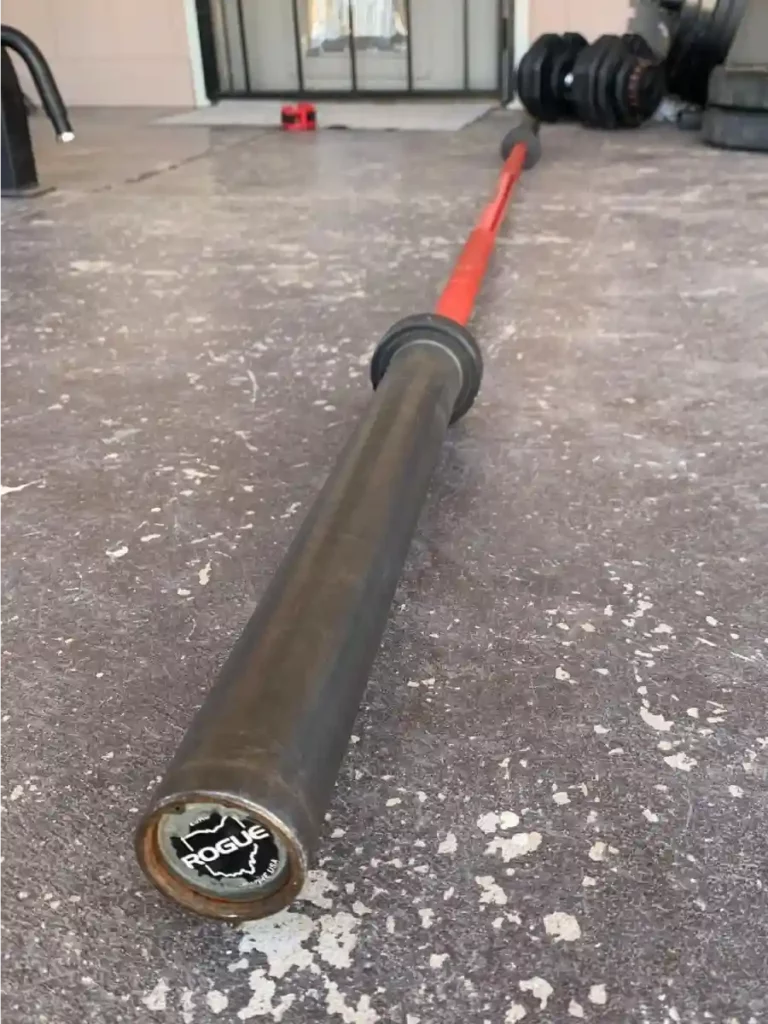
Barbells are a versatile training tool found in virtually all strength training gyms.
You can use barbells to train most of the major compound movements and muscle groups.
Barbells also allow you to lift the most weight for a given movement pattern, which is useful for stimulating maximal strength and hypertrophy gains.
Barbells do have some downsides.
The biggest is that the straight bar does not always facilitate the optimal biomechanical patterns, which can cause problems for athletes dealing with mobility issues.
For healthy athletes using a variety of training methods and proper technique, this is not usually a problem.
I generally recommend that all BJJ athletes develop competency with barbell movements as part of a comprehensive BJJ strength training program.
Barbell Back Squat
The barbell back squat is a phenomenal way to build strength and hypertrophy in the glutes, hamstrings and quads, which are key muscles for BJJ.
Additionally, the stability required to maintain the barbell on your upper traps and keep your torso from falling forward provides a substantial isometric strengthening stimulus in the core and back muscles.
This strengthens your lower back stabilizer muscles, which is an absolute must if you want to minimize the wear and tear on your low back from Jiu Jitsu.
Depending on where you place the bar (high or low bar position), the back squat emphasizes the glutes or quads, among other muscles.
Barbell front squats are an option as well, which shift emphasis towards the quads.
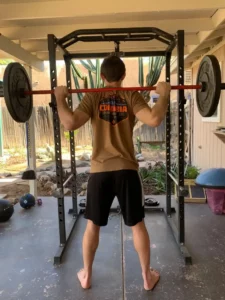

Movement pattern: squat.
Primary muscles worked (1):
- Gluteus maximus (glutes)
- Biceps femoris & semitendinosus (hamstrings)
- Rectus femoris, vastus lateralis, & vastus medialis (quads)
Note: Throughout the movement, ensure your knees track in line with your toes. It is okay if your knees pass your toes as you reach the lower portions of the squat, but do not allow them to cave inwards during the lift.
Barbell Deadlift & Variations
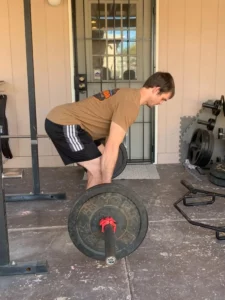
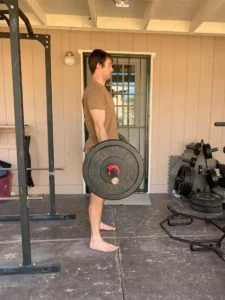
The barbell deadlift is a versatile movement that primarily trains the hip hinge pattern. Deadlifts hit the quads, hamstrings, and glutes with the emphasis depending on which variation is used.
There are multiple variations of barbell deadlift, including:
- Standard deadlift
- Romanian deadlift
- Sumo deadlift
Movement pattern: hip hinge, squat (depending on variations).
Primary muscles worked (2):
- Gluteus maximus (glutes)
- Biceps femoris & semitendinosus (hamstrings)
- Rectus femoris, vastus lateralis, & vastus medialis (quads)
- Adductors (sumo variation)
Trap Bar Deadlifts & Squats

Trap bar deadlifts, alternatively called hex bar deadlifts or squats, are a safe and effective way to train squat and hip hinge movements.
The standard trap/hex bar squat focuses more on a squat pattern, although it is somewhat of a hybrid movement.


You can make various adjustments to the lifting technique to target different lower body muscle groups.
Muscles targeted (1):
- Gluteus maximus (glutes)
- Biceps femoris (hamstrings)
- Rectus femoris, vastus lateralis, & vastus medialis (quads)
Barbell Hip Thrusts


Barbell hip thrusts, also called barbell glute bridges, are an excellent way to build strong, powerful glutes.
They transfer well to the bridging movements in BJJ.
I highly recommend including barbell hip thrusts in Jiu Jitsu weight training programs.
You will need some sort of pad for the barbell across your lap for comfort.
Movement pattern: hip hinge
Primary muscles worked (3):
- Gluteus maximus (glutes)
- Erector spinae
- Hamstrings
- Quadriceps femoris
Barbell Overhead Press


Barbell overhead presses hit the muscles in your shoulder and isometrically train your whole body to stabilize the weight during the press.
Movement pattern: vertical pressing.
Primary muscles worked (4):
- anterior, medial and posterior deltoid
- upper trapezius
- pectoralis major
- triceps brachii
Barbell Row

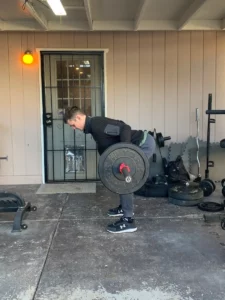
Barbell rows are a powerful way to train your upper back as well as your grip strength and torso stability.
Movement pattern: horizontal pulling.
Primary muscles worked:
- Rhomboids
- Lats
- Middle and lower traps
- Posterior deltoid
Barbell Bench Press
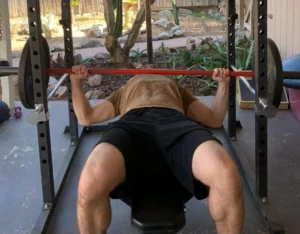

The barbell bench press is a foundational barbell exercise and a staple for training the chest muscles. Although it does pose some increased injury risk compared to other chest pressing variations, the bench press remains a safe way to develop serious upper body pressing strength when proper form and progression are maintained.
Movement pattern: horizontal pressing.
Primary muscles worked (5):
- Pectoralis major
- Triceps brachii
- Anterior deltoid
- Serratus anterior muscle
- Elbow flexors
- Biceps brachialis
Barbell Landmine Exercises
The barbell landmine attachment greatly increases the versatility of your barbell. It allows you to perform excellent rotational movements as well as presses, rows, and more.
Example barbell landmine exercises include:
- Landmine rotations
- Kneeling landmine press
- T-bar row
Bodyweight Exercises for BJJ
Side Plank
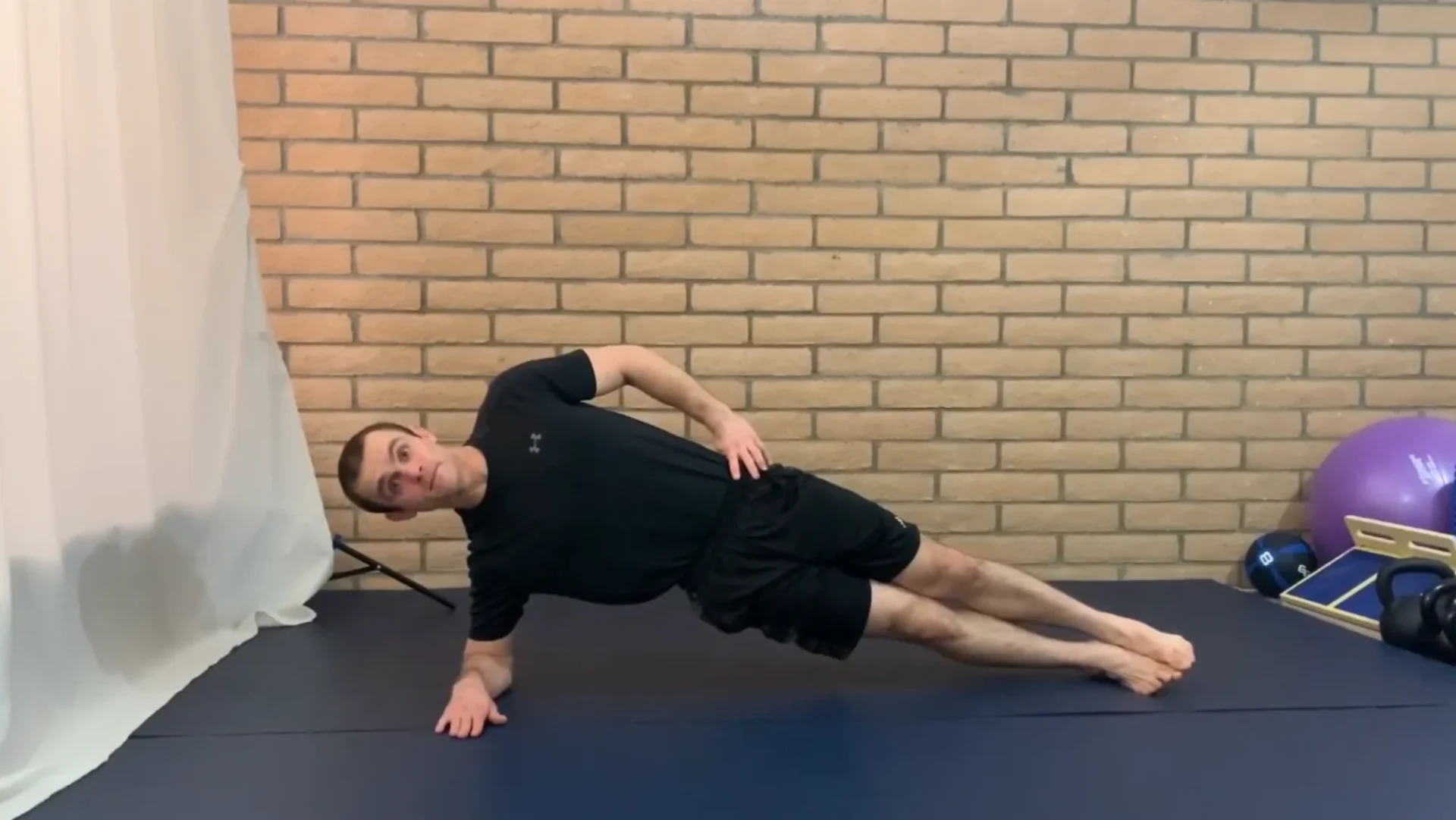
The side plank is one of my favorite BJJ core exercises for stability that I use as part of a low back pain prevention routine and warm-up before lifting or as a standalone workout.
You can do side planks by using a static hold or by lowering your hip back down and performing repetitions of side bridges.
Note, this choice of exercise is inspired by the “McGill Big 3,” core exercises.
Movement pattern: core lateral stability.
Primary muscles worked (5):
- Rectus abdominis
- External oblique
- Erector spinae
- Lumbar multifidus
- Gluteus medius
- Tensor fasciae latae
Bird-Dogs

Bird-dogs are another amazing core rotational stability exercise great for lower back health and activating your stabilizers prior to heavier lifts. It also builds shoulder stability due to the posted arm carrying the weight of your upper body.
Movement pattern: core rotational stability.
Primary muscles worked (6):
- Kneel on a stable exercise table, mat, or floor.
- Position the hands directly under the shoulders at shoulder width with the fingers facing forward.
- Position the knees and feet hip width apart with feet dorsiflexed.
- Pre-brace the abdominals and core muscles by attempting to contract the muscles and placing the spine in a neutral position, prior to initiating the ascent.
Dead Bugs

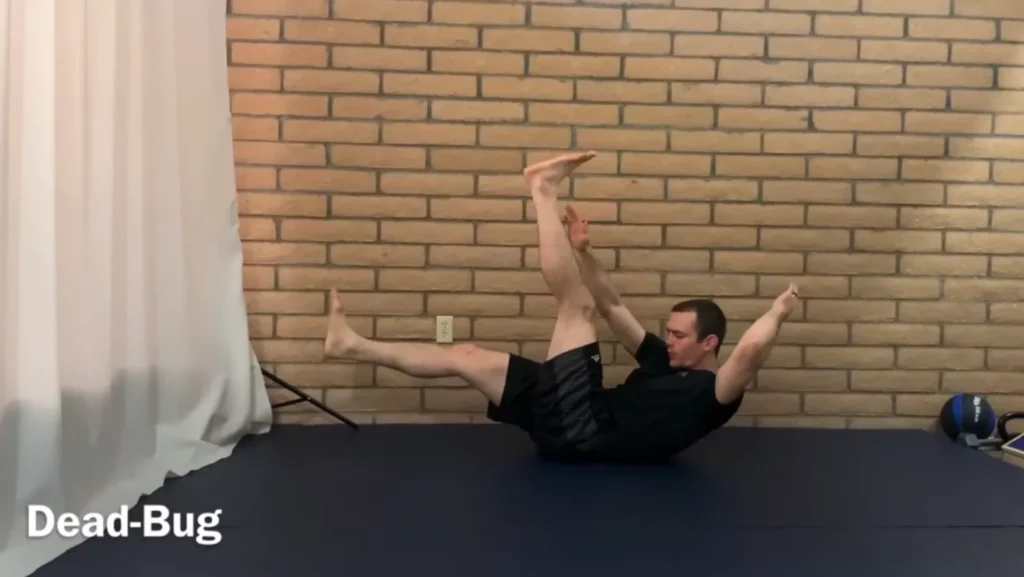
Dead bugs are an excellent stabilization exercise for the front of your core. They round out the 3 main core exercises, that I typically include some variation of at the beginning of any workout involving significant load on the spinal column.
Movement pattern: core stability.
Primary muscles worked (7):
- Rectus abdominis
- External obliques
- Internal obliques
Knees to Chest


Knees to chest is an excellent core exercise for BJJ. It trains similar movements to the hip flexion required for closed-guard, butterfly guard, and other guard positions in Jiu Jitsu.
Movement pattern: frontal core strength.
Primary muscles worked:
- Rectus abdominis
- Multifidus
- External obliques
- Internal obliques
Dips
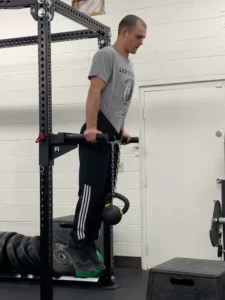

Dips are an upper body exercise that use parallel bars, rings, or a bench to hit a variety of muscles in your chest, shoulders, core, and back.
Note: add weight via weight belt or other methods.
Movement pattern: horizontal pressing (decline angle).
Primary muscles worked:
- Triceps
- Anterior deltoid
- Pec major and minor
- Rhomboid muscles in the back
Pull Ups


Pull-ups and their variations are hands down the best all-around upper body exercises especially regarding BJJ.
Pullup exercises target the major pulling muscles in your upper body and offer a variety of grip options to provide varying stimulus. You can also use a thicker pull-up bar to add more grip demands.



Some Jiu Jitsu athletes use towel pullups to train their Gi grips, but I personally find that puts too much strain on my fingers without a ton of extra benefits.
Note: add weight via weight belt or other methods.
Movement pattern: vertical pulling.
Primary muscles worked (8):
- Latissimus dorsi
- Biceps brachii
- Posterior deltoid
- Middle trapezius
Push Ups


Push-ups are the classic bodyweight chest exercise that you can do virtually anywhere. In addition to the chest muscles, they hit your shoulders as well as your core stability.
You can use pushups as a direct chest training exercise with progressions in weight or variations.
Alternatively you can use them as a component of your upper body warmup once performing many repetitions becomes easy.
Pushups provide many variation options including:
- Diamond pushups
- wide grip push ups
- Explosive push ups
- One-arm pushups
Movement pattern: horizontal pressing.
Primary muscles worked (9):
- Deltoids
- Pectoralis minor
- Pectoralis major
- Serratus anterior
- Biceps brachii
- Triceps brachii
Single Leg Floor Bridge


If you want to hit your glutes with minimal-to-no equipment, then the single leg floor bridge is an excellent choice. This variation of the double leg floor bridge adds an additional rotational stability effort while concentrating the force onto one leg. It’s an excellent exercise for BJJ as well since many escape movements mimic the double and single leg floor bridge.
Primary muscles worked (10):
- Gluteus maximus (glutes)
- Erector spinae
- Hamstrings
- Quadriceps femoris
Bodyweight Squat
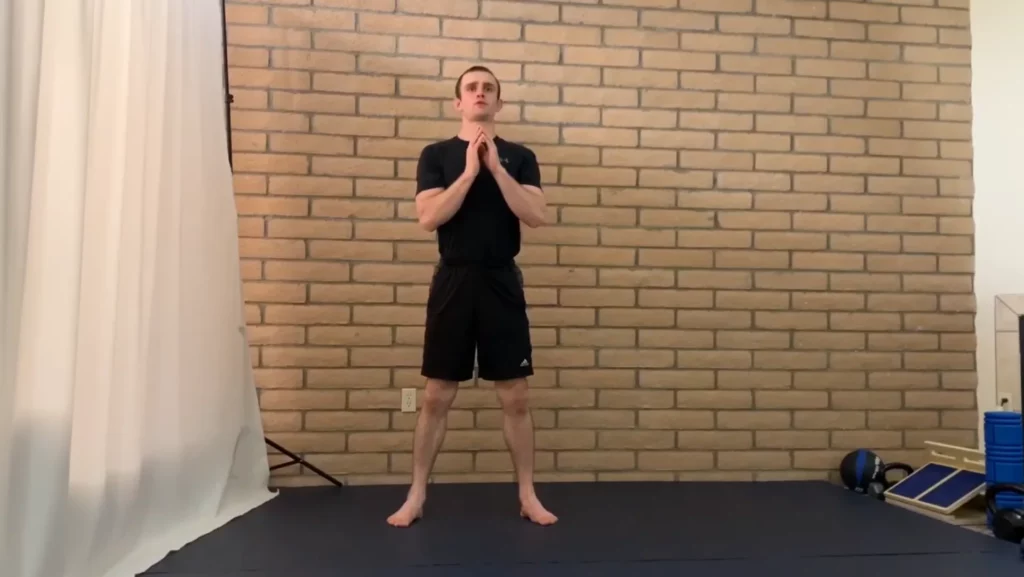
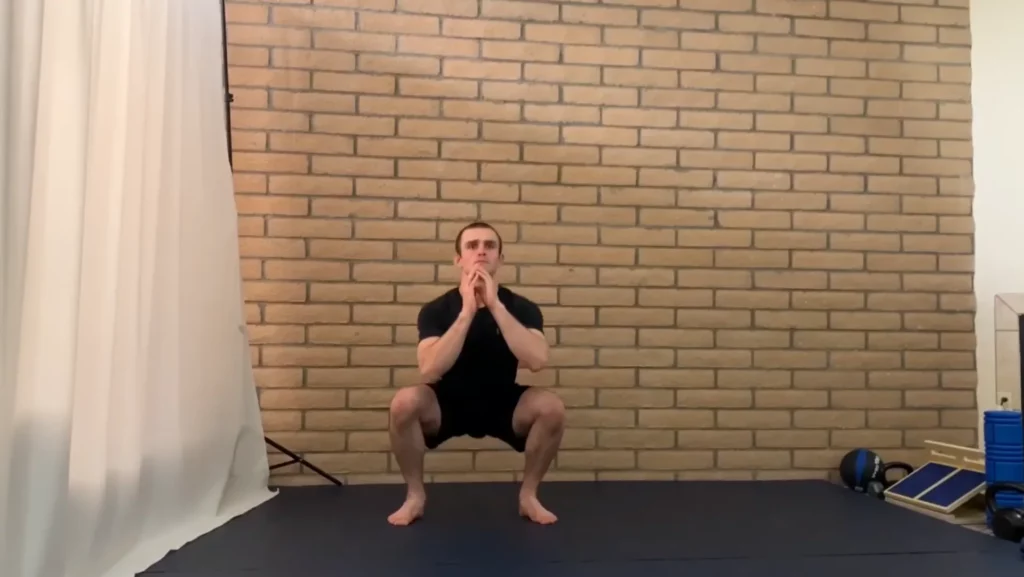
If you struggle with barbell squats or are just starting your BJJ lifting journey, bodyweight squats are an excellent way to train this movement pattern while developing the coordination and strength to begin adding external resistance.
Movement pattern: squat.
Primary muscles worked (11):
- Gluteus maximus (glutes)
- Biceps femoris & semitendinosus (hamstrings)
- Rectus femoris, vastus lateralis, & vastus medialis (quads)
Bodyweight Lunge


Lunges are a foundational movement for all athletic and day-to-day activity, including movements in BJJ.
Movement pattern: lunge.
Muscles worked:
- Gluteus maximus (glutes)
- Erector spinae
- Hamstrings
- Quadriceps femoris
Side Lunge
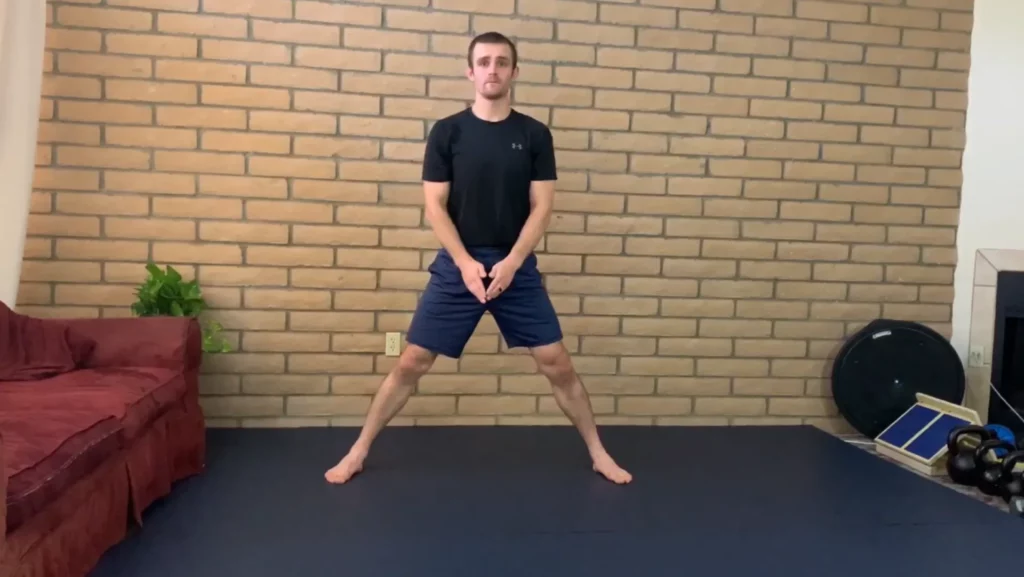

Side lunges train your outer hips and also help improve groin and hip mobility. You can add weight by holding a dumbbell, but I generally like using side lunges as a warm up movement as opposed to primary movement.
Muscles worked:
- Gluteus medius
- Gluteus maximus
- Quadriceps
- Adductors
Dumbbell Exercises for BJJ

Dumbbells are a versatile tool for strength and conditioning exercises. They offer more variety of exercises than barbells, although you cannot typically lift as much weight. Dumbbells also tend to be more forgiving on the joints if you follow proper form.
The following are a few of my favorite dumbbell exercises for Jiu-Jitsu.
Dumbbell Bench Press


The dumbbell variation of the bench press is a bit more forgiving on the shoulders, follows a more natural range of motion, and allows you to vary your grip from prone to neutral.
From my experience with this exercise, the overall movement of a dumbbell bench press when you have your arms at around 45-degrees seems the smoothest on the chest and shoulders.
Movement pattern: horizontal pressing.
Primary muscles worked:
- Pectoralis major
- Triceps brachii
- Anterior deltoid
- Serratus anterior muscle
- Elbow flexors
- Biceps brachialis
Dumbbell Floor Press
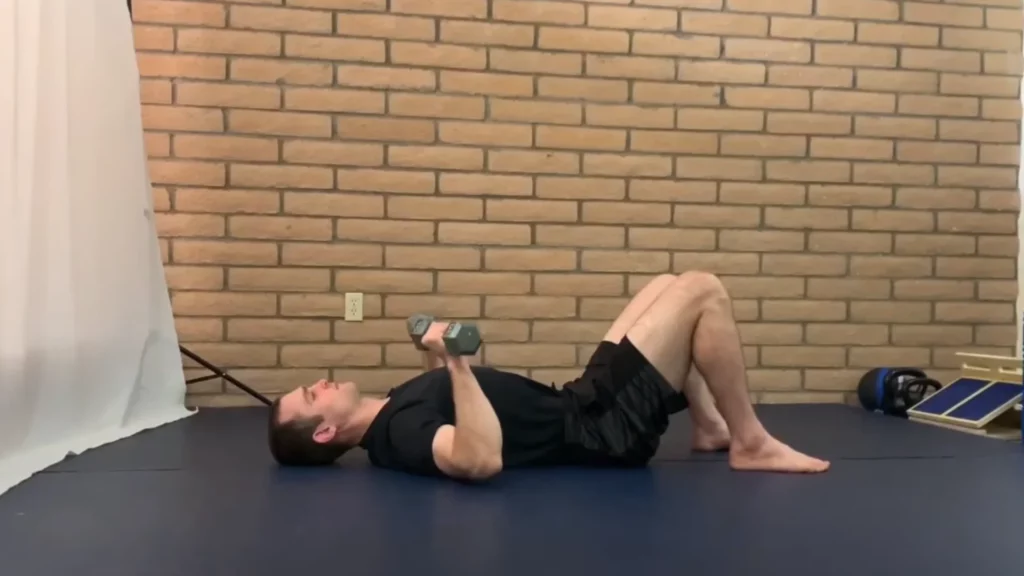
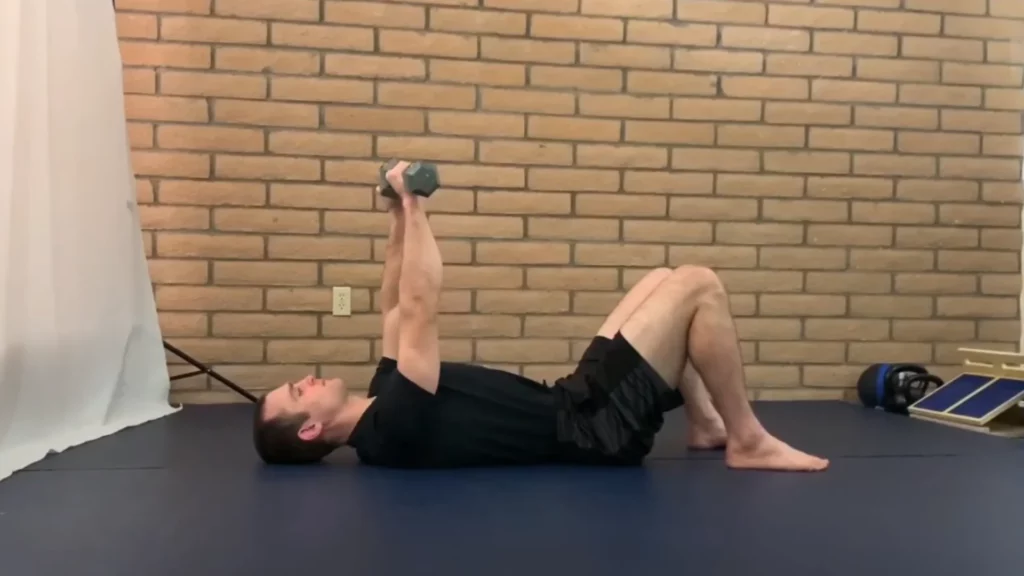
Performing the dumbbell chest press while lying on the floor limits how low your elbows can go, which can be helpful if you tend to get shoulder strain.
Additionally, despite the reduced range of motion, having your back on the floor is a more realistic position for BJJ when creating frames or doing other similar motions, so dumbbell floor presses are technically more “sport specific” than the bench version.
Dumbbell Row


Dumbbell rows allow you to hit one arm at a time with fairly heavy weights using a rowing motion.
Compared to a barbell row, I find the dumbbell row grip better mimics the hand position used in BJJ when arm dragging or performing other explosive pulling movements during live Jiu Jitsu rolls.
Movement pattern: horizontal pulling.
Primary muscles worked:
- Rhomboids
- Lats
- Middle and lower traps
- Posterior deltoid
Dumbbell Overhead Press


The dumbbell overhead press places less strain on the shoulders compared to a barbell overhead press and is a fairly safe way to load the overhead press movement.
Movement pattern: vertical pressing.
Primary muscles worked:
- Anterior, medial, and posterior deltoid
- Upper trapezius
- Pectoralis major
- Triceps brachii
Dumbbell Squat

Performing squats holding one or two dumbbells is a good way to add resistance up to ~50lbs. I recommend starting with dumbbell squat variations before trying barbell squats.
Movement pattern: squat.
Primary muscles worked (12):
- Gluteus maximus (glutes)
- Biceps femoris & semitendinosus (hamstrings)
- Rectus femoris, vastus lateralis, & vastus medialis (quads)
Dumbbell Glute Bridge
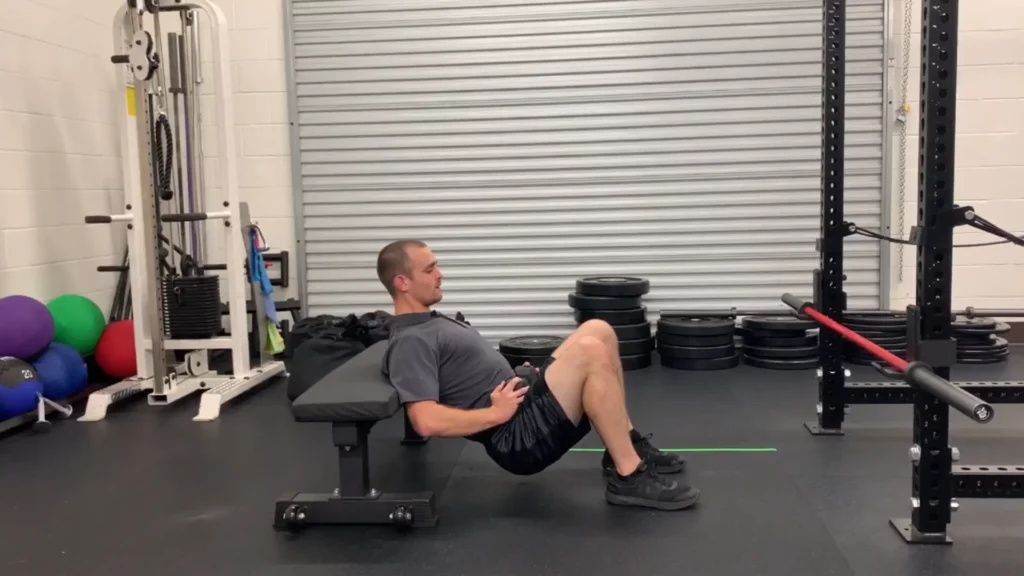

If you don’t have access to a barbell or are using a lower amount of weight, you can perform hip thrusts/glute bridges with a dumbbell.
Movement pattern: hip hinge
Primary muscles worked (13):
- Gluteus maximus (glutes)
- Erector spinae
- Hamstrings
- Quadriceps femoris
Dumbbell Split Squat


Also called a Bulgarian split squat, the dumbbell split squat is actually a lunge movement pattern exercise.
Essentially, you are performing a lunge with your rear foot elevated on a surface. The distance of your planted foot from the surface should match your normal lunge distance.
Movement pattern: lunge.
Muscles targeted (14):
- Gluteus maximus
- Gluteus medius
- Vastus medialis
- Vastus lateralis
- Rectus femoris
- Biceps femoris
- Semitendinosus
- Gastrocnemius
Dumbbell Alternating Lunge
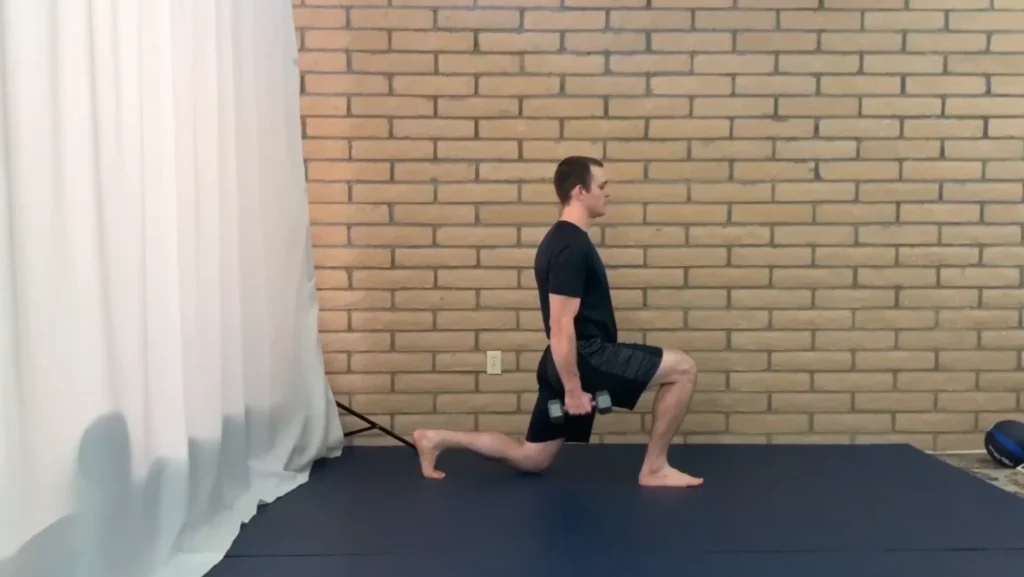


Alternating lunges with dumbbells are a great strength exercise and can also be incorporated into circuit training.
Movement pattern: lunge.
Muscles worked:
- Gluteus maximus
- Erector spinae
- Hamstrings
- Quadriceps femoris
Jiu Jitsu Plyometric Training
Plyometric training encompasses a range of activities that involve a rapid eccentric movement followed by a concentric movement.
Research shows plyometric activities can enhance strength and power, and often require less or even no additional weight.
Incorporating one or two exercises such as squat jumps, single leg jumps, box jumps, and other jumping-related activities into your program can help you reap the performance benefits of plyometric training for Jiu Jitsu as part of your overall development.
Example Plyometric Exercises for BJJ
Squat Jumps
Tuck Jumps
Single Leg Hops
Box Jumps
Burpees
Alternative Implement Training for BJJ

Alternative implements are non-traditional weight training methods such as kettlebells, slam balls, and sandbags. Thankfully, you can find much of this equipment in mainstream commercial gyms.
Kettlebells
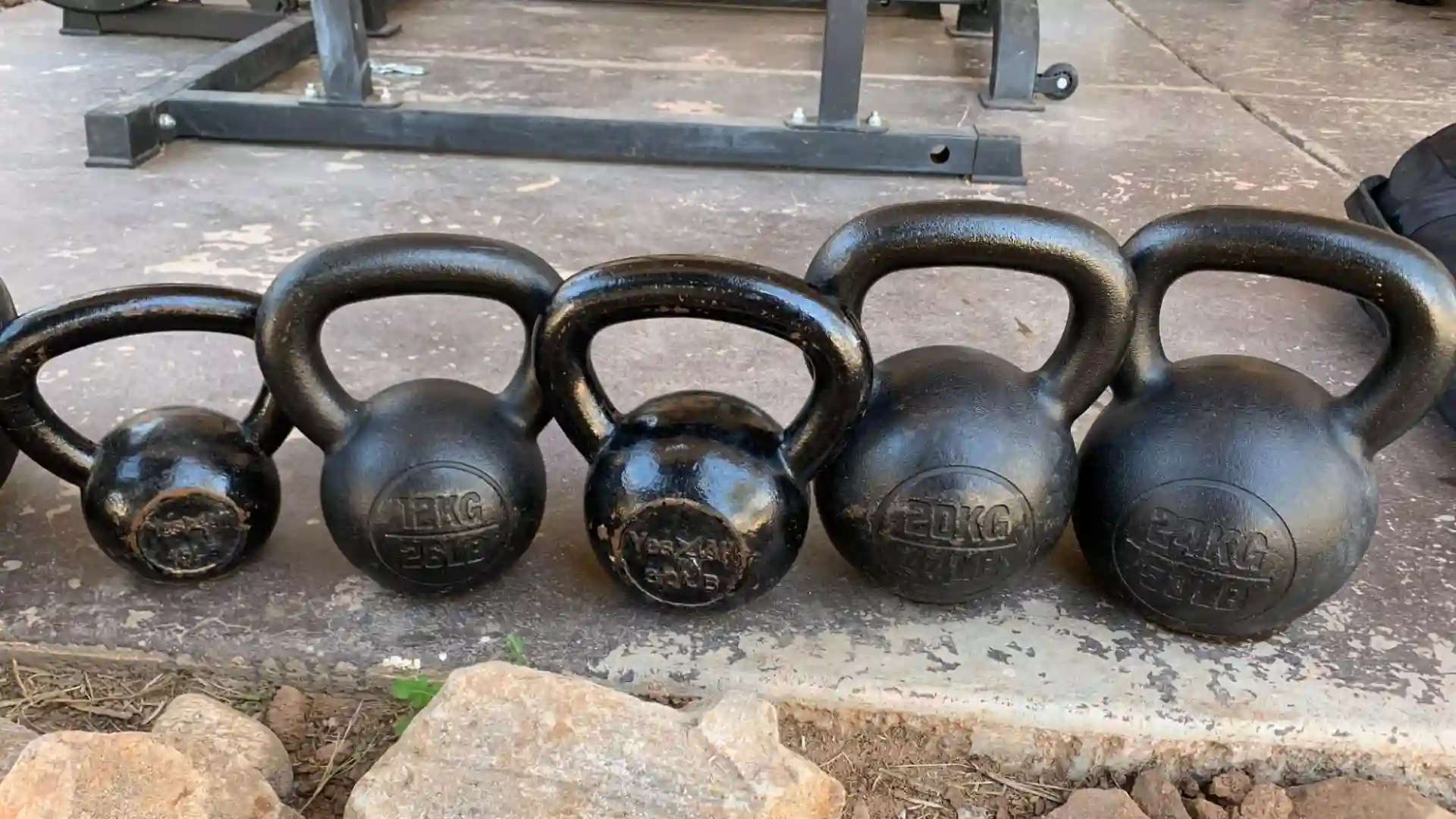
BJJ kettlebell workouts are a popular training method in the Jiu Jitsu community, and for good reason.
They offer an unparalleled combination of strength, endurance, and stability exercises while being relatively forgiving on form.
Research on the “Hardstyle” kettlebell training popularized by Pavel Tsatsouline, showed improved performance outcomes in participants.
Furthermore, numerous athletes can testify to the effectiveness of kettlebells in your training program.
Example Kettlebell Exercises for Jiu Jitsu
While there are virtually endless kettlebell exercises you can do for BJJ, the following are a few of my top picks.
Kettlebell Goblet Squat
Kettlebell Romanian Deadlift
Kettlebell Swing
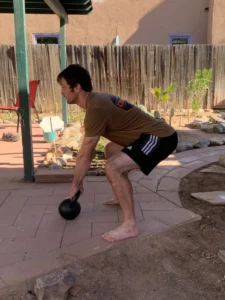
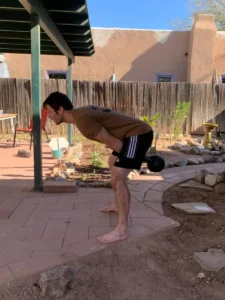

Turkish Get Up


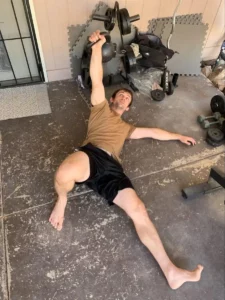
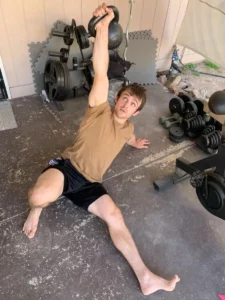



Kettlebell Snatch


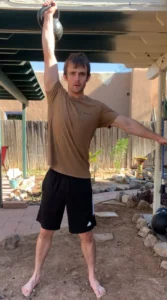
Check out the quick kettlebell snatch demonstration below to add them to your BJJ strength and conditioning program.
Sandbags

Sandbags are a versatile training tool that you can use for explosive work, strength training, and stability.
My favorite BJJ sandbag training circuit involves performing a sandbag clean followed by different sandbag carry variations.
I find sandbags provide the best combination of resistance and ability to maneuver the weight at around 30-50 percent of my 1 repetition maximum.
Example Sandbag Exercises for BJJ
Sandbag Clean


Sandbag Push Press
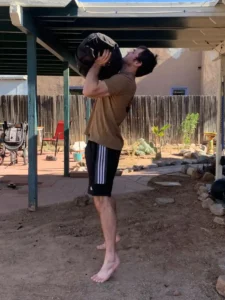

Sandbag Zercher Squats


Sandbag Carries

Sandbag Slams

Sport-Specific BJJ Exercises
Many exercises can be made more “sport-specific” to BJJ by focusing on a specific athletic requirement in Jiu Jitsu and incorporating it into standard exercises.
Examples include keeping your knees up in flexion and even holding a medicine ball between them when doing pullups to mimic the hip flexion demands of playing Jiu Jitsu guard, among other positions.
Using implements with wider diameter on the handles when pulling, such as “fat” bar pull ups, can also better mimic the pulling grip demands in grappling since wrists, elbows, ankles, and other body parts are thicker than a standard barbell.


You can also turn a sandbag carry into a BJJ exercise by slamming it and performing a knee-on-belly transition between your lifts.

I personally think it’s okay to keep most of your BJJ strength and conditioning focused on traditional strength movements.
However, I do like to add one or two “Jiu Jitsu specific” variations of movements into workouts.
Just don’t get too distracted finding the “perfect exercise” that you neglect the fundamental strength exercises for grapplers.
Science-Based BJJ Workout Principles
When it comes to the best BJJ strength and conditioning programs, there are few hard and fast rules as to the exact optimal strength and conditioning program for Jiu Jitsu.
In the past few years, researchers have begun testing different protocols for Brazilian Jiu Jitsu strength and conditioning. However, as of now, there is no unified or universally agreed-upon approach.
What we do know is that in terms of BJJ competition, research shows that higher levels of anaerobic, aerobic, and muscular fitness directly improves BJJ performance.
As such, if your goal is Jiu-Jitsu performance, then BJJ strength and conditioning is a must.
In this next section, you’ll learn more of the BJJ strength and conditioning science guidelines for strength, conditioning, and cardio for BJJ.
BJJ Strength Training Guidelines
Strength training for BJJ usually aims at improving maximal strength, power, and muscular hypertrophy through a combination of resistance training exercises.
Additionally, strength training with heavy loads increases the strength of bones, tendons, and ligaments, which helps protect against injury and improves physical longevity.
Jiu Jitsu athletes can benefit from an extra focus on grip strength, hip flexor and extensor strength, and isometric holds in addition to core rotational strength.
I always emphasize using the greatest possible ranges of motion to promote stability and strength from a variety of joint positions.
General strength training for Jiu Jitsu can follow a variety of guidelines.
In my experience, BJJ athletes without prior strength training experience see substantial benefits from standard resistance training guidelines for grappling exercise.
These guidelines typically focus on stability and technique lifting before transitioning into muscle growth, maximal strength, and finally, BJJ explosive training for a comprehensive program.
In my experience and research, the specific weight and repetition count is less important provided that the weight provides sufficient challenge at the chosen repetition range.
This is especially true for beginner lifters.
Additionally, recent research analysis suggests that strength, power, and endurance can be improved using a variety of repetition and weight setups.
As athletes become more advanced, you do need to get more specific with strength and conditioning protocols to drive adaptations.
Due to the relatively new growth in Jiu Jitsu’s popularity, complete Jiu Jitsu strength training guidelines are less studied than other sports.
However, recent research gives some insight into various protocols and benefits of strength training for Jiu-Jitsu.
A 2015 study looked at various loads using a bench press throw for BJJ non-advanced and advanced athletes, which correlates to upper body strength and power.
The study found that using 42% of 1 rep maximum allows for the optimal development of muscular power in the BJJ athlete research subjects.
While extrapolating this data is not an exact science, this does suggest that submaximal power training can play a valuable role in Jiu Jitsu strength training programs.
Another study conducted in 2018 found that maximal strength training using 4 sets of 4 repetitions at 85% of a 1-repetition maximum resulted in increased muscular strength, muscular endurance, and countermovement jump height in Jiu-Jitsu athletes.
This suggests that low-repetition, high-resistance training protocols will drive improvements in maximal strength, power, and muscular endurance when performed in conjunction with Brazilian Jiu-Jitsu training.
In my experience, following scientifically-studied BJJ strength and conditioning guidelines is great, but you often run into the practical problems of equipment availability, athlete movement competence, and recovery needs when dealing with recreational athletes who also have day jobs and cannot recover between sessions to the same extent as professional athletes.
With that said, my general rule of thumb for BJJ strength training is that most Jiu Jitsu athletes will benefit from resistance training using low to moderate repetitions on a variety of compound strength movements.
I also incorporate plyometrics training and implement training, such as sandbag and kettlebell exercises.
Over the course of a grappling strength program, I begin athletes at higher reps with moderate weight before moving to lower reps with high weight, and finally, adding speed and explosiveness once the athlete develops their base strength.
I focus on the following fundamental movement patterns with the different exercises:
- Horizontal pushing/pulling (ie. rows, dumbbell flat press)
- Vertical pushing/pulling (ie. pull ups, overhead press) – shoulder flexion and extension
- Squat (ie. goblet squat, hex bar squat)
- Hip hinge and hip extension (ie. Romanian deadlift, hip thrusters)
- Lunge (ie. forward lunges, Bulgarian split squats)
Many standard strength and conditioning exercises can be modified to target BJJ-specific adaptations such as grip strength, hip abductor and adductor strength, and core strength.
BJJ Conditioning Guidelines
If you’ve ever participated in a grappling scramble or series of fast-paced transitions, you know the feeling of muscle burn, gasping for breath, and trying to prepare yourself for the next immediate exchange.
The ability to quickly recover from a grappling exchange and be ready for the next one depends on having great Jiu-Jitsu conditioning.
People often equate conditioning with cardio, but they are not the same thing. Cardio, or aerobic capacity, reflects the body’s relative ability to provide aerobic energy at a given intensity, and it is important for Jiu-Jitsu.
However, metabolic conditioning is more sport-specific and requires training in the primary energy systems used in each sport.
In the case of Brazilian Jiu-Jitsu, researchers found that competition-intensity BJJ relies heavily on the anaerobic-glycolytic energy pathway. The glycolytic energy system typically provides energy for high-intensity activities lasting anywhere from 10-90 seconds. This anaerobic glycolysis results in the buildup of lactate, and is associated with the ‘burning’ sensation often felt in muscles following intense activity.
Excess lactate buildup in the muscle results in fatigue and eventual muscular failure. The body clears lactate naturally at varying rates and uses it for a wide range of biological functions.
Training the glycolytic system reduces the lactate buildup at a given anaerobic intensity and also improves the rate at which lactate is cleared, thus allowing better recovery from intense scrambles during BJJ.
For BJJ, the best cardio workouts focus on glycolytic training, which revolves around on-off intervals of high intensity and low intensity using one of more cardio exercises.

In my experience, keeping the work and rest intervals between 10 and 30 seconds using sprints, Airbike, explosive bodyweight exercises, or even live grappling result in substantial improvements to grappling conditioning.
My own personal BJJ conditioning program uses 20 seconds on-off intervals on the Airbike for 5-6 minutes to simulate a match.
Regardless of the exact method you use, in my experience, you can drastically improve your Jiu-Jitsu conditioning using this type of interval training.
Cardio for BJJ
Cardiovascular fitness refers to your body’s ability to sustain a given exercise output using aerobic energy. Better cardio fitness also correlates to reduced risk factors for metabolic diseases, although that goes beyond sports performance.
The aerobic system is capable of providing energy for very long duration activities that do not meet the previously discussed threshold of requiring anaerobic glycolysis.
Cardiovascular training, called ‘cardio’ for short, decreases the energy demand of a given submaximal output.
In layman’s terms, this means you can grapple for longer periods of time at a medium intensity pace without becoming exhausted.
Combined with the anaerobic conditioning, better grappling cardio will allow higher intensity bouts of fighting with briefer recovery times over longer match durations.
Cardio for BJJ is especially vital when competing in tournaments with many matches.
By the time you hit your fourth or fifth match in competition, strength and explosiveness will start to diminish, and you will need to rely on cardio and technique to finish your opponents in the deep water of the late matches.
You can train cardio for grappling using a variety of different methods. Longer runs, swims, or other aerobic modalities are popular.
I am also a big fan of using actual live Jiu Jitsu training to improve cardio.
You can do this by increasing the duration of each training round and/or adding additional rolls at the end of class.
Plus, this combines actual BJJ technique with aerobic training, meaning more ‘bang for your buck’ in terms of BJJ performance compared to regular cardio.
That being said, you can only train so much live BJJ each week, so using a lower impact modality can be beneficial for additional cardio training.
How I wrote this guide

My name is Jordan Fernandez and I have been a certified strength and conditioning coach (CSCS) and personal trainer (NASM-CPT) for the past 4 years. I am also a recreational Brazilian Jiu Jitsu athlete and hold the rank of BJJ purple belt.
During my time, I had the opportunity to work with many individuals from the Jiu Jitsu community to develop their strength and conditioning for BJJ.
I’ve also had the chance to learn from other amazing Jiu Jitsu strength and conditioning coaches to inform my knowledge.
As part of this article, I interviewed a few of the top subject matter experts on the topic of BJJ strength and conditioning and include their insights within the article as well as the full discussion.
I often rely on the knowledge and experience of other BJJ S&C coaches to fill in the gaps in the research that arise during the practical side of programming strength and conditioning for Jiu-Jitsu.
I focus my training principles on the latest research from the National Strength and Conditioning Association combined with knowledge gleaned from recent research focused directly on Jiu Jitsu strength and conditioning.
Overall, I have seen enough BJJ strength transformations to trust the combination of experience and research laid out in this article for Brazilian Jiu-Jitsu strength and conditioning.
Jiu Jitsu Strength and Conditioning Frequently Asked Questions (FAQs)
Should you do Olympic lifts for BJJ?
If you can safely and effectively perform Olympic lifts, then including Olympic lifts for BJJ strength and conditioning can be a good idea. If you don’t know the correct Olympic lifting technique, then I do not recommend including these lifts in your Jiu Jitsu workout program.
Do you need strength and conditioning for BJJ?
Overall, yes, you do need strength and conditioning for BJJ, especially if you want to maximize performance. Even if you are not a heavy competitor, strength training helps your body stay strong, avoid injury, and increase your longevity on the mats.
How often should you strength train for BJJ?
Generally speaking, aim to strength train for BJJ between 2-4 days per week. The exact optimal training frequency depends on your experience, available time for training and recovery, and fitness goals.
How strong is strong enough for BJJ?
It’s hard to say exactly how strong you should be for BJJ. As a general guideline, I recommend athletes work towards at minimum of 1.5x bodyweight back squat 1RM, 2x bodyweight deadlift 1RM, 1x bodyweight bench press 1RM, 0.5-0.8x bodyweight 1RM overhead press, and be able to perform 10 bodyweight pull ups with strict form.
What is the best workout for BJJ?
The best workout for BJJ includes core training, full body strength and power, and BJJ-focused conditioning. Mobility training is also highly recommended.
Is deadlifting good for BJJ?
Yes. Deadlifts and their variations can be highly beneficial exercises for BJJ strength training when performed using proper technique and progression.
What kind of workout is BJJ?
BJJ is primarily an anaerobic workout when training Jiu Jitsu at high intensity, and more of an aerobic workout at lower intensity rolling in BJJ.
Is BJJ enough of a workout?
BJJ is enough of a workout to meet recommended exercise guidelines and improve cardio and conditioning. Jiu Jitsu is not enough of a workout to build muscle.
Does BJJ build muscle?
No. Generally speaking, BJJ does not provide the stimulus required to build muscle. Jiu Jitsu can help burn calories and help with weight loss.
How do you train your body for BJJ?
In addition to regular Jiu Jitsu training, BJJ workouts with compound strength exercises are the best way to train your body for BJJ.
What will BJJ do to your body?
BJJ changes your body in a variety of ways. You may lose weight with Jiu Jitsu and trim up. You brain develops new movement patterns for grappling. You may also get injured in BJJ.
What are the benefits of a BJJ workout?
Benefits of BJJ workouts include strength, mobility, muscle growth, conditioning, and improved BJJ performance.
What are the best exercises for a BJJ workout?
The best exercises for a BJJ workout are compound, dynamic movements that use a full range of motion and focus on overall physical strength and performance such as squats, deadlifts, pull-ups, and push-ups.
What are the best ways to warm up for a BJJ workout?
The best warmups include light aerobics, core activation, and mobility in the areas needed to complete the training session.
What are the best ways to cool down after a BJJ workout?
Cooling down with some light stretching, core, and deep breathing helps reset the body after a BJJ workout.
BJJ Workout Programs: the bottom line
Strength and conditioning for BJJ is a massive topic, and there really is no one size fits all.
The best approach is following general science-backed guidelines and developing a program around your training experience, exercises you feel comfortable with and can perform well, and of course, your available training time and goals.
While elite athletes will need highly specific programs under the guidance of a professional strength and conditioning coach, the vast majority of BJJ practitioners can see massive gains from the type of programming outlined in this article.
We hope it was helpful for informing your strength and conditioning for Jiu Jitsu.
We’ll see you at the gym, and on the mats.
Explore similar topics:
Explore other topics:



